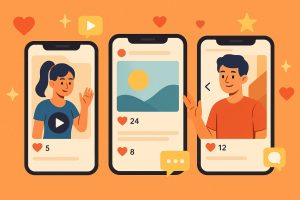Real Stories From Real People
People trust what other people say. On social platforms, that trust can grow quickly when brands share content made by their own fans. This is what user-generated content (UGC) brings to the table—something raw, real, and relatable. A shared photo, video, or post from a customer carries a tone that doesn’t feel staged.
Whether it’s someone showing off their favorite coffee mug or posting their latest DIY result, UGC connects because it reflects genuine experience. That moment feels honest. It wasn’t crafted by a brand team. It came from someone who wanted to share.
In a feed full of polished graphics, real voices stand out. That authenticity is why UGC has become such a powerful part of social media strategy.
Building Trust Without Saying a Word
Every review, selfie, or comment from a user is more than content—it’s social proof. It tells others that someone tried something and liked it enough to post. No special editing. No polished pitch. Just a snapshot of real usage.
Think of a skincare brand that reposts before-and-after photos from customers. That says more than any product description. It gives future buyers confidence to try it for themselves.
When people see others using your product, they feel less pressure. It lowers the risk in their mind. This quiet trust-building plays a big role in turning followers into buyers.
Cost-Effective Content Creation
Creating content takes time and budget. Shooting videos, designing graphics, writing captions—it all adds up. But user-generated content brings a steady flow of content created by the audience itself, ready to be reused and celebrated.
A clothing brand, for example, can highlight customers’ outfit posts each week. That means less planning and more variety. It also adds different voices to your feed, which keeps things fresh.
Instead of investing heavily in every post, smart brands mix in what their community already shares. It saves time and shows appreciation.
Community Involvement That Feels Natural
People like being part of something. When a brand shares their photo or story, they feel seen. This motivates others to join in, too. One shared post can spark dozens more as followers want their moment in the spotlight.
UGC encourages two-way interaction. It’s not just a brand broadcasting—it’s a brand responding. This builds a sense of belonging. When users know their voice is valued, they return again and again.
That shared energy often leads to stronger loyalty. Not because of rewards or sales, but because it feels good to be noticed.
Content Variety That Reflects the Audience
User-generated content brings in more than one style or tone. It adds color to a feed by reflecting different backgrounds, interests, and personalities. That variety shows the full picture of who uses your product or joins your event.
A travel company may post scenic photos from across the globe, all taken by different travelers. Each photo tells its own story, in its own voice. That’s something brand photography can’t always capture.
By posting UGC, brands show they’re listening—and they care about everyone in their circle, not just the ideal customer.
Boosting Engagement Without Forcing It
People are more likely to comment or share when they see themselves in the post—or when they feel it’s someone just like them. UGC taps into this by showing content created by peers.
That familiarity sparks interaction. It might be a quick “That’s me!” reply or a friend tagging someone. Either way, it increases reach and invites more participation.
Instead of trying to force comments or likes, brands can invite organic engagement simply by letting their community lead the way.
Turning Happy Customers Into Advocates
When someone posts about your brand without being asked, that’s a clear sign of satisfaction. These people are already your fans. Sharing their content helps turn them into advocates.
An advocate doesn’t just buy—they talk, recommend, and respond to others. Highlighting their content adds fuel to that advocacy. It tells them their opinion matters, and others might listen too.
Even better, advocates often help answer questions in the comments. They become informal ambassadors, ready to help newcomers understand why they love the brand.
Making Campaigns More Inclusive
Not every brand can create ads that speak to everyone—but their audience can. UGC opens the door to more inclusive content by featuring a range of faces, styles, and settings.
It might be a small business sharing customer photos from different age groups, cultures, or lifestyles. That kind of representation sends a clear message: everyone’s welcome.
It also brings out stories the brand might never think to tell. When the audience shares their own experiences, it makes the campaign feel bigger, broader, and more human.
Encouraging More Social Proof Through Incentives
Sometimes, a gentle nudge helps generate more UGC. Campaigns that invite users to post with a branded hashtag or enter a small contest can motivate content creation.
For example, a fitness app could ask users to share their workout photo each Monday. No prize needed—just the chance to be featured. Over time, that builds a library of authentic posts.
These small incentives create a loop. More posts mean more visibility, which inspires more users to join in. The cycle grows naturally, all fueled by the audience itself.
Strengthening Brand Relationships One Share at a Time
At first glance, resharing a customer’s post might appear minor, but it carries significant emotional weight. This simple act transforms a one-time buyer into a visible and celebrated member of the brand’s community. It’s no longer just about a transaction—it’s about inclusion in a larger narrative. When people see themselves reflected in a brand’s content, it nurtures a sense of belonging that can’t be replicated by traditional advertising.
Every interaction—whether it’s a repost, a public thank-you, or a thoughtful comment—sends a message that the brand is listening. These gestures show that behind the polished logo and curated content is a team that truly values its audience. Customers begin to feel less like passive consumers and more like collaborators. They start shaping the brand’s identity through their experiences, feedback, and stories, giving the brand a more human, relatable voice.
This recognition builds something deeper than one-time attention. Over time, these interactions cultivate loyalty rooted in mutual respect and appreciation. It’s not driven by flashy promotions or loyalty points, but by genuine acknowledgment. When a customer feels seen and appreciated, they’re more likely to stay engaged, return, and advocate for the brand in their own networks—creating a self-sustaining loop of trust and enthusiasm.











No responses yet